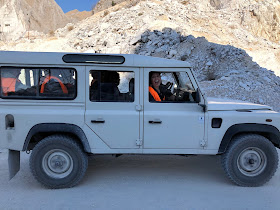Saturday, February 16, 2019
 We visited Pisa on Saturday morning, February 16th. The Field of Miracles is a collection of four buildings: the baptistery, a cathedral, a bell tower, (all crafted in an Eastern-influenced style that became known as the Pisan Romanesque), and a cemetery. In the 11th century, before the Arno River completely cut off the city from the ocean, the sea the sea came to just outside the walls of Pisa. The cathedral, one of the largest in the world, spread out before the sea. a monument of gleaming white marble. The cathedral was built outside the city walls to demonstrate that Pisa's power did not require any special protection. The Duomo was consecrated on September 26, 1118.
We visited Pisa on Saturday morning, February 16th. The Field of Miracles is a collection of four buildings: the baptistery, a cathedral, a bell tower, (all crafted in an Eastern-influenced style that became known as the Pisan Romanesque), and a cemetery. In the 11th century, before the Arno River completely cut off the city from the ocean, the sea the sea came to just outside the walls of Pisa. The cathedral, one of the largest in the world, spread out before the sea. a monument of gleaming white marble. The cathedral was built outside the city walls to demonstrate that Pisa's power did not require any special protection. The Duomo was consecrated on September 26, 1118. The golden ceiling was added during Meici's rule in the 16th century. The bronze doors were built in the 17th century by Florentine artists after the original wooden doors were destroyed in a fire that severely damaged the cathedral.
The baptistery was the second building constructed after the cathedral. It is the largest baptistery in Italy. Galileo was baptized here in 1565. Construction spanned over 200 years, revealed by the different architectural styles in the exterior. The vault consists of a double dome - an inner cone and an outer dome which gives the building exceptional acoustics. Our guide sang a few notes and the reverberation allowed us to hear echoes that lasted long enough for three-part harmony - solo!
I was surprised to learn that the Leaning Tower of Pisa is actually a bell tower. Part of the collection of marble buildings in the Field of Miracles, it was begun in 1173, but not completed until about 200 years later. By the time the second story was guilt, it was clear that the building was leaning due to the unstable soil. The tower would surely have fallen if construction had continued at that time but the slow pace of the project allowed the soil to settle enough for construction to continue. A restoration project from 1999-2001 restored the lean from 5.5 degrees in 1990 to 3.99. Experts believe the tower should stand for at least another 200 years.
The Monumental Cemetery of Pisa was the final structure to be built on the Piazza del Duomo. The earth of the grassy courtyard was thought to have been carried back from Palestine in the Second Crusade and therefor earned the name composanto, literally "holy field." Can you spot the bride being photographed on the pedestal?
I've never been afraid of heights, but I had to close my eyes several times on the hairpin turns as I looked down to "where we had come from." That might have been compounded by my seat in the back of the jeep looking right over the edge of the road.
Here's some of modern equipment we saw used by sculptors today. For more details about how digital technology aids in sculpting today, see the article - From Copenhagen to Carrara to Rome.






















Every time I read one of these posts, I think, "Italy is a place I must visit!" Thank you!
ReplyDeleteI admire the commitment you have shown to record your travels. I can imagine that it gives you a lot of pleasure to look at the photos and take a trip down the memory lane.
ReplyDelete